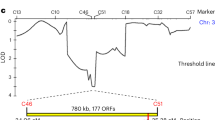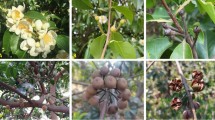Abstract
Sexual reproduction in many angiosperm plants involves self-incompatibility (SI), which is one of the most important mechanisms to prevent inbreeding. SI is genetically controlled by the S-locus, and involves highly specific interactions during pollination between pollen and the pistil on which it lands. This results in the rejection of incompatible (‘self’) pollen, whereas compatible (‘non-self’) pollen is allowed to fertilize the plant1. In Papaver rhoeas, S-proteins encoded by the stigma component of the S-locus interact with incompatible pollen, triggering a Ca2+-dependent signalling network2,3,4,5,6,7, resulting in the inhibition of pollen-tube growth. Programmed cell death (PCD) is a mechanism used by many organisms to destroy unwanted cells in a precisely regulated manner8,9,10. Here we show that PCD is triggered by SI in an S-specific manner in incompatible pollen. This provides a demonstration of a SI system using PCD, revealing a novel mechanism to prevent self-fertilization. Furthermore, our data reveal that the response is biphasic; rapid inhibition of pollen-tube growth is followed by PCD, which is involved in a later ‘decision-making’ phase, making inhibition irreversible.
This is a preview of subscription content, access via your institution
Access options
Subscribe to this journal
Receive 51 print issues and online access
$199.00 per year
only $3.90 per issue
Buy this article
- Purchase on Springer Link
- Instant access to full article PDF
Prices may be subject to local taxes which are calculated during checkout



Similar content being viewed by others
References
Franklin-Tong, V. E. & Franklin, F. C. H. Gametophytic self-incompatibility inhibits pollen tube growth using different mechanisms. Trends Plant Sci. 8, 598–605 (2003)
Franklin-Tong, V. E., Ride, J. P., Read, N. D., Trewavas, A. J. & Franklin, F. C. H. The self-incompatibility response in Papaver rhoeas is mediated by cytosolic free calcium. Plant J. 4, 163–177 (1993)
Rudd, J. J., Franklin, F. C. H., Lord, J. M. & Franklin-Tong, V. E. Increased phosphorylation of a 26-kD pollen protein is induced by the self-incompatibility response in Papaver rhoeas. Plant Cell 8, 713–724 (1996)
Rudd, J. J., Osman, K., Franklin, F. C. H. & Franklin-Tong, V. E. Activation of a putative MAP kinase in pollen is stimulated by the self-incompatibility (SI) response. FEBS Lett. 547, 223–227 (2003)
Geitmann, A., Snowman, B. N., Emons, A. M. C. & Franklin-Tong, V. E. Alterations in the actin cytoskeleton of pollen tubes are induced by the self-incompatibility reaction in Papaver rhoeas. Plant Cell 12, 1239–1251 (2000)
Snowman, B. N., Kovar, D. R., Shevchenko, G., Franklin-Tong, V. E. & Staiger, C. J. Signal-mediated depolymerization of actin in pollen during the self-incompatibility response. Plant Cell 14, 2613–2626 (2002)
Jordan, N. D., Franklin, F. C. H. & Franklin-Tong, V. E. Evidence for DNA fragmentation triggered in the self-incompatibility response in pollen of Papaver rhoeas. Plant J. 23, 471–479 (2000)
Raff, M. Cell suicide for beginners. Nature 396, 119–122 (1998)
Mittler, R. & Lam, E. Sacrifice in the face of foes: pathogen-induced programmed cell death in plants. Trends Microbiol. 4, 10–15 (1996)
Fukuda, H. Programmed cell death of tracheary elements as a paradigm in plants. Plant Mol. Biol. 44, 245–253 (2000)
Nagata, S., Nagase, H., Kawane, K., Mukae, N. & Fukuyama, H. Degradation of chromosomal DNA during apoptosis. Cell Death Differ. 10, 108–116 (2003)
Scovassi, A. I. & Poirier, G. G. Poly(ADP-ribosylation) and apoptosis. Mol. Cell. Biochem. 199, 125–137 (1999)
Salvesen, G. S. & Dixit, V. M. Caspase activation: the induced-proximity model. Proc. Natl Acad. Sci. USA 96, 10964–10967 (1999)
Wolf, B. B., Schuler, M., Echeverri, F. & Green, D. R. Caspase-3 is the primary activator of apoptotic DNA fragmentation via DNA fragmentation factor-45/inhibitor of caspase-activated DNase inactivation. J. Biol. Chem. 274, 30651–30656 (1999)
Wolf, B. B. & Green, D. R. Suicidal tendencies: Apoptotic cell death by caspase family proteinases. J. Biol. Chem. 274, 20049–20052 (1999)
Garcia-Calvo, M. et al. Inhibition of human caspases by peptide-based and macromolecular inhibitors. J. Biol. Chem. 273, 32608–32613 (1998)
Richael, C., Lincoln, J. E., Bostock, R. M. & Gilchrist, D. G. Caspase inhibitors reduce symptom development and limit bacterial proliferation in susceptible plant tissues. Physiol. Mol. Plant Pathol. 59, 213–221 (2001)
Danon, A., Rotari, V. I., Gordon, A., Mailhac, N. & Gallois, P. Ultraviolet-C overexposure induces programmed cell death in Arabidopsis, which is mediated by caspase-like activities and which can be suppressed by caspase inhibitors, p35 and defender against apoptotic death. J. Biol. Chem. 279, 779–787 (2004)
Woltering, E. J., van der Bent, A. & Hoeberichts, F. A. Do plant caspases exist? Plant Physiol. 130, 1764–1769 (2002)
Adrain, C. & Martin, S. J. The mitochondrial apoptosome: a killer unleashed by the cytochrome seas. Trends Biochem. Sci. 26, 390–397 (2001)
Balk, J., Leaver, C. J. & McCabe, P. F. Translocation of cytochrome c from the mitochondria to the cytosol occurs during heat induced programmed cell death in cucumber plants. FEBS Lett. 463, 151–154 (1999)
Franklin-Tong, V. E., Drøbak, B. K., Allan, A. C., Watkins, P. A. C. & Trewavas, A. J. Growth of pollen tubes of Papaver rhoeas is regulated by a slow moving calcium wave propagated by inositol 1,4,5 trisphosphate. Plant Cell 8, 1305–1321 (1996)
Babiychuk, E. et al. Higher plants possess two structurally different poly(ADP-ribose) polymerases. Plant J. 15, 635–645 (1998)
Lepiniec, L., Babiychuk, E., Kushnir, S., Vanmontagu, M. & Inze, D. Characterization of an Arabidopsis thaliana cDNA homologue to animal poly(ADP-ribose) polymerase. FEBS Lett. 364, 103–108 (1995)
Smith, S. The world according to PARP. Trends Biochem. Sci. 26, 174–179 (2001)
Franklin-Tong, V. E., Holdaway-Clarke, T. L., Straatman, K. R., Kunkel, J. G. & Hepler, P. K. Involvement of extracellular calcium influx in the self-incompatibility response of Papaver rhoeas. Plant J. 29, 333–345 (2002)
Dickinson, H. G. Simply a social disease? Nature 367, 517–518 (1994)
Hodgkin, T., Lyon, G. D. & Dickinson, H. G. Recognition in flowering plants: a comparison of the Brassica self-incompatibility system and plant pathogen interactions. New Phytol. 100, 557–569 (1988)
Kakeda, K. et al. Identification of residues in a hydrophilic loop of the Papaver rhoeas S protein that play a crucial role in recognition of incompatible pollen. Plant Cell 10, 1723–1731 (1998)
Laemmli, U. K. Cleavage of structural proteins during the assembly of the head of bacteriophage T4. Nature 227, 680–685 (1970)
Acknowledgements
We thank C. Franklin and B. de Graaf for a critical reading of the manuscript. This work was funded by the BBSRC.
Author information
Authors and Affiliations
Corresponding author
Ethics declarations
Competing interests
The authors declare that they have no competing financial interests.
Rights and permissions
About this article
Cite this article
Thomas, S., Franklin-Tong, V. Self-incompatibility triggers programmed cell death in Papaver pollen. Nature 429, 305–309 (2004). https://doi.org/10.1038/nature02540
Received:
Accepted:
Issue Date:
DOI: https://doi.org/10.1038/nature02540
This article is cited by
-
Ac-DEVD-CHO (caspase-3/DEVDase inhibitor) suppresses self-incompatibility–induced programmed cell death in the pollen tubes of petunia (Petunia hybrida E. Vilm.)
Cell Death Discovery (2024)
-
A pair of non-Mendelian genes at the Ga2 locus confer unilateral cross-incompatibility in maize
Nature Communications (2022)
-
Incompatible pollen abortion and late-acting self-incompatibility in Schima superba
Scientific Reports (2022)
-
Microbial interaction mediated programmed cell death in plants
3 Biotech (2022)
-
Structure of antipodal cells nuclei of wheat embryo sac during programmed cell death
Planta (2021)
Comments
By submitting a comment you agree to abide by our Terms and Community Guidelines. If you find something abusive or that does not comply with our terms or guidelines please flag it as inappropriate.



